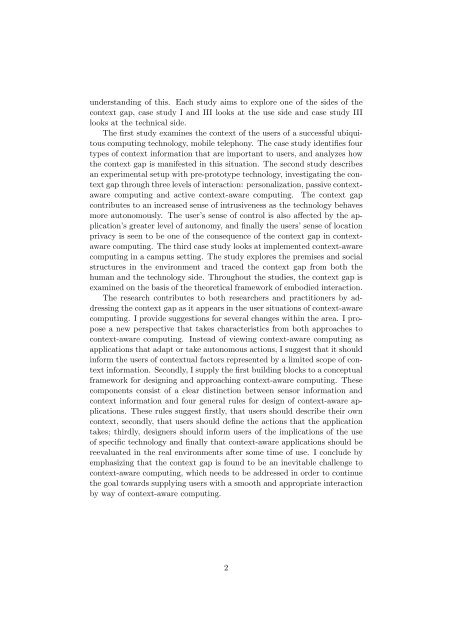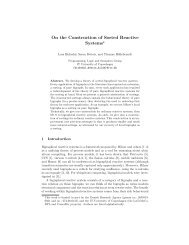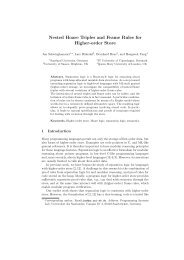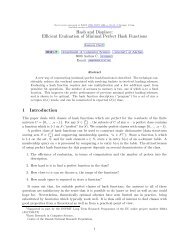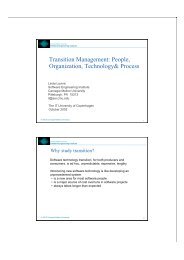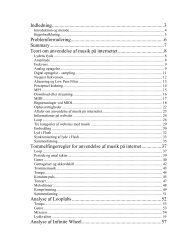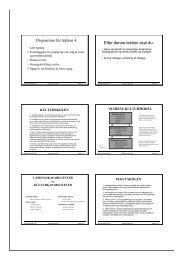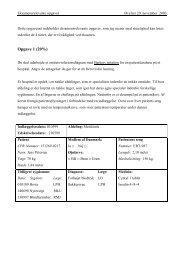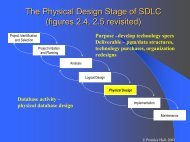The Context Gap: An Essential Challenge to Context-Aware ...
The Context Gap: An Essential Challenge to Context-Aware ...
The Context Gap: An Essential Challenge to Context-Aware ...
Create successful ePaper yourself
Turn your PDF publications into a flip-book with our unique Google optimized e-Paper software.
understanding of this. Each study aims <strong>to</strong> explore one of the sides of the<br />
context gap, case study I and III looks at the use side and case study III<br />
looks at the technical side.<br />
<strong>The</strong> first study examines the context of the users of a successful ubiqui<strong>to</strong>us<br />
computing technology, mobile telephony. <strong>The</strong> case study identifies four<br />
types of context information that are important <strong>to</strong> users, and analyzes how<br />
the context gap is manifested in this situation. <strong>The</strong> second study describes<br />
an experimental setup with pre-pro<strong>to</strong>type technology, investigating the context<br />
gap through three levels of interaction: personalization, passive contextaware<br />
computing and active context-aware computing. <strong>The</strong> context gap<br />
contributes <strong>to</strong> an increased sense of intrusiveness as the technology behaves<br />
more au<strong>to</strong>nomously. <strong>The</strong> user’s sense of control is also affected by the application’s<br />
greater level of au<strong>to</strong>nomy, and finally the users’ sense of location<br />
privacy is seen <strong>to</strong> be one of the consequence of the context gap in contextaware<br />
computing. <strong>The</strong> third case study looks at implemented context-aware<br />
computing in a campus setting. <strong>The</strong> study explores the premises and social<br />
structures in the environment and traced the context gap from both the<br />
human and the technology side. Throughout the studies, the context gap is<br />
examined on the basis of the theoretical framework of embodied interaction.<br />
<strong>The</strong> research contributes <strong>to</strong> both researchers and practitioners by addressing<br />
the context gap as it appears in the user situations of context-aware<br />
computing. I provide suggestions for several changes within the area. I propose<br />
a new perspective that takes characteristics from both approaches <strong>to</strong><br />
context-aware computing. Instead of viewing context-aware computing as<br />
applications that adapt or take au<strong>to</strong>nomous actions, I suggest that it should<br />
inform the users of contextual fac<strong>to</strong>rs represented by a limited scope of context<br />
information. Secondly, I supply the first building blocks <strong>to</strong> a conceptual<br />
framework for designing and approaching context-aware computing. <strong>The</strong>se<br />
components consist of a clear distinction between sensor information and<br />
context information and four general rules for design of context-aware applications.<br />
<strong>The</strong>se rules suggest firstly, that users should describe their own<br />
context, secondly, that users should define the actions that the application<br />
takes; thirdly, designers should inform users of the implications of the use<br />
of specific technology and finally that context-aware applications should be<br />
reevaluated in the real environments after some time of use. I conclude by<br />
emphasizing that the context gap is found <strong>to</strong> be an inevitable challenge <strong>to</strong><br />
context-aware computing, which needs <strong>to</strong> be addressed in order <strong>to</strong> continue<br />
the goal <strong>to</strong>wards supplying users with a smooth and appropriate interaction<br />
by way of context-aware computing.<br />
2


